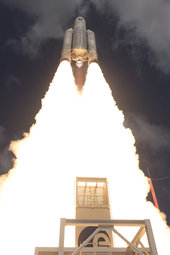Two further satellites have formally become part of Europe’s Galileo satnav system, broadcasting timing and navigation signals worldwide while also picking up distress calls across the planet.
These are the 15th and 16th satellites to join the network, two of the four Galileos that were launched together by Ariane 5 on 17 November, and the first additions to the working constellation since the start of Galileo Initial Services on 15 December.
The growing number of Galileo users around the world will draw immediate benefit from the enhanced service availability and accuracy brought by these extra satellites.
The launch into space and the manoeuvres to reach their final orbits still left a lot of rigorous testing before the satellites could join the operational constellation.
This lengthy testing saw the satellites being run from the second Galileo Control Centre in Oberpfaffenhofen, Germany, while their signals were assessed from ESA’s Redu centre in Belgium, with its specialised antennas.
The tests measured the accuracy and stability of the satellites’ atomic clocks – essential for the timing precision to within a billionth of a second as the basis of satellite navigation – as well as assessing the quality of the navigation signals.
Oberpfaffenhofen and Redu were linked for the entire campaign, allowing the team to compare Galileo signals with satellite telemetry in near-real time.
Making the tests even more complicated, the satellites were visible for only three to nine hours a day from each site.
The satellites are now broadcasting working navigation signals and are ready to relay any Cospas–Sarsat distress calls to regional emergency services.
Now that these two satellites are part of the constellation, the remaining pair from the Ariane 5 launch is similarly being checked to prepare them for service.








Be the first to comment on "Galileo grows: two more satellites join working constellation"